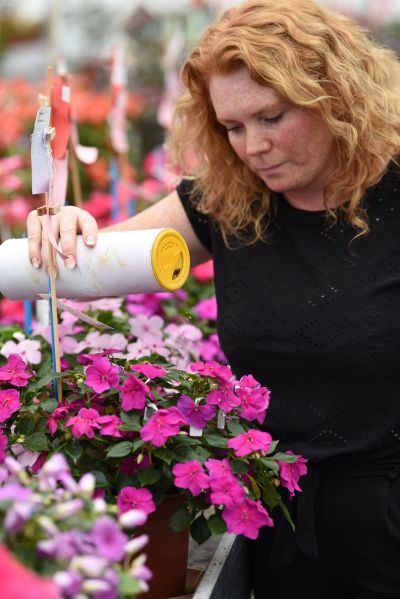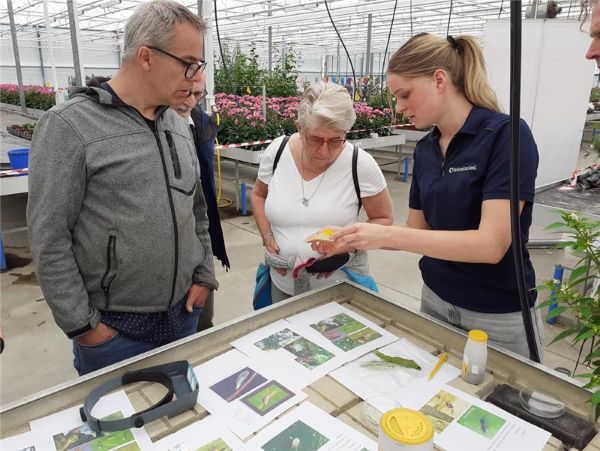
Winning the Pest Battle from Seed to Plant: Our Take on Biological Control
At PanAmerican Seed®, we don’t just supply seeds—we grow with you. We know that growing healthy plants from seed isn’t just about genetics or germination rates. It’s also about protection—especially in those early, vulnerable stages.
Whether you're working with plugs, trays or early-stage crops, pest pressure can hit hard—and fast. That’s why biological pest control is becoming a vital tool for many of our grower partners. We’ve seen firsthand how biologicals can help keep crops healthy, balanced and chemical-free right from the start.
Here’s what we’ve learned, what’s working, and a few tips from our partners and growers in the field.
From Sowing to Growing: Which Biologicals Work Best?
Even in the early stages of growth, there are natural predators that can help prevent outbreaks before they get out of hand.
For Thrips
• Orius laevigatus – A generalist predator that handles both larvae and adult thrips
• Transeius montdorensis – Focuses on thrips larvae and works well under greenhouse conditions
For Aphids
• Aphidius spp. – Tiny parasitic wasps that lay eggs inside aphids
• Chrysoperla carnea – Lacewing larvae that devour aphids at every stage
• Aphidoletes aphidimyza – Great for “hot spots”; midge larvae hunt aphids directly in clusters
For Whitefly
• Encarsia formosa – Well-known parasitic wasp that works best in warm conditions
• Macrolophus pygmaeus – A strong all-around predator, but slower to establish
For Fungus Gnats (Sciara and Scatella)
• Hypoaspis spp. – Soil mites that patrol plug trays and young crops to prevent larval damage
For Caterpillars
• Trichogramma spp. – Tiny wasps that prevent moths by parasitizing their eggs
For Spider Mites
• Phytoseiulus persimilis – A highly targeted predator that wipes out mites quickly
What Are Growers Seeing in Early-Stage Crops?
Growers working with seed tell us their biggest early-stage problems are:
• Fungus gnats in trays and plugs
• Thrips, which often come in from surrounding areas and build up fast
• Aphids during the transition to outdoor or warmer greenhouse conditions
• Whitefly, which is present year-round, but is especially fast to multiply in Summer
• Caterpillars, which often start in nearby ornamentals or outdoor areas
When dealing with young plants, there’s little margin for error, so early detection and preventative action are key.
Why Plant Type Matters in Biological Success
From what we’ve seen and heard, plants that produce pollen give biologicals a real advantage. Pollen supports beneficials when pest populations are low, helping predator populations build early.
Some growers use banker plants (like lavender and pepper) to boost Orius or lacewing populations ahead of the season. Others supplement with targeted feeds like Powerfood Plus 3.0, especially in the seedling phase before flowering begins.
Choosing the Right Predator—And When
Biological control isn’t one-size-fits-all. Growers choose based on:
• Pest pressure and life stage
• Temperature and humidity
• Daylight hours (e.g., Orius needs at least 12 hours of light)
• Crop sensitivity
We always recommend staying up to date with supplier advice. Our growers trust sources like Koppert and Royal Brinkman, and their technical advisors, to fine-tune what, when and how much to release.

Why Go Biological Early?
The top reasons our growers choose biologicals, especially from the seed stage:
• No resistance buildup
• Reduced chemical use (especially important with new restrictions)
• Better for crop health, worker safety and the environment
• Compatible with IPM (Integrated Pest Management)
Yes, some biologicals take a few days to arrive. But, with weekly scouting and historical data, growers are learning to anticipate instead of reacting.
Challenges to Watch Out For
One of our partner growers once noticed a sudden drop in Orius numbers without any spraying involved. The cause was unclear, but their advisor suggested soil and plant testing for residues or biological stress.
The solution? Reintroduce the predator, but expect a delay while populations rebuild. Lesson learned: timing and careful handling are everything.
Is It Working? Can You Measure Success?
While nobody’s counting every insect, most growers track biological success through scouting. If a grower sees beneficials in most sample plants, and pests are under control—that’s a win.
For example:
“If we spot Orius in 4 out of 5 trays and don’t find thrips, we know we’re doing something right.”
Climate and Timing Make a Difference
Every beneficial insect has its own temperature and humidity preferences. Just one example:
• At 20°C, Orius takes ~3 weeks to develop
• At 25°C, that drops to about 15 days
Matching predator development to crop conditions helps maximize impact.
A Few Tips from the Field
If you're thinking of introducing biological pest control from the seed stage onward, here’s what experienced growers recommend:
• Start early—don’t wait for pests to build up
• Use banker plants to maintain populations
• Feed beneficials with the right supplements (Powerfood Plus 3.0 is a favourite for Orius and mites)
• Avoid spraying anything incompatible with beneficials
• Keep scouting records—you’ll be better prepared every season
Let’s Grow Better, Together
At PanAmerican Seed®, we believe in supporting growers with not just the best genetics, but also the tools and knowledge to protect young plants naturally. Whether you’re just starting to explore biological control or already deep into IPM, we’re here to help.
Have questions? Need recommendations for your crops?
Contact our team—we're happy to help you grow smarter from seed to plant.